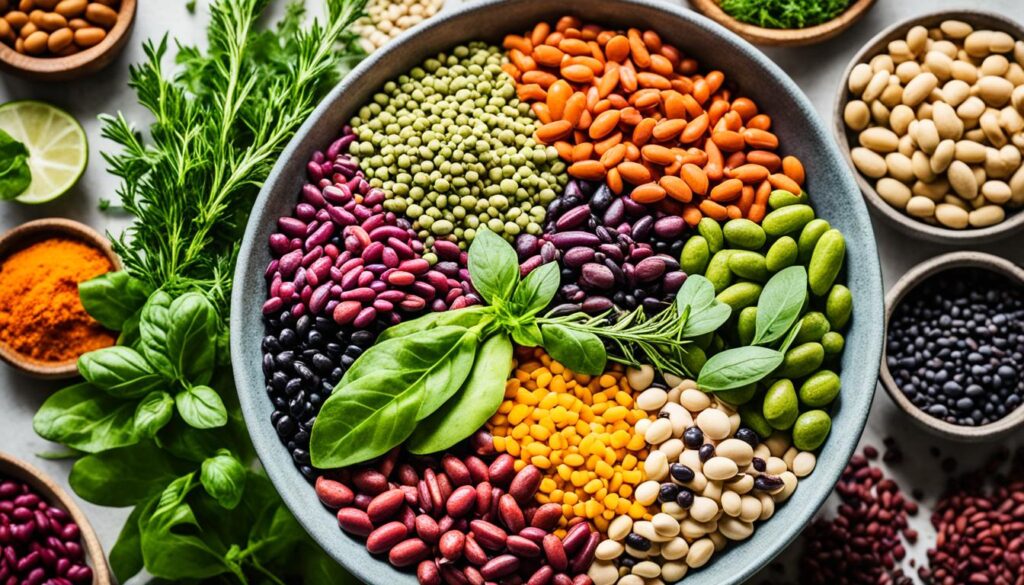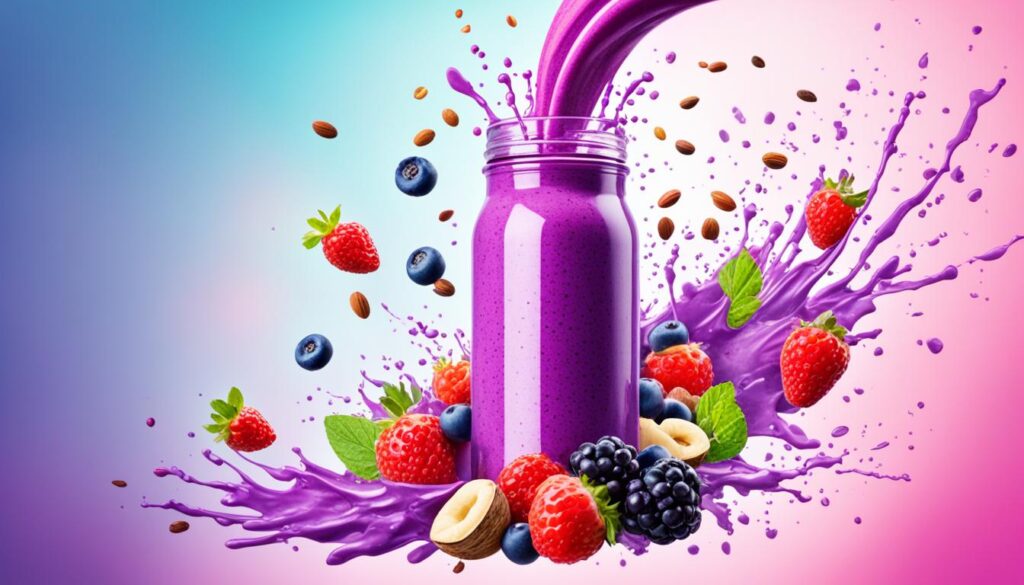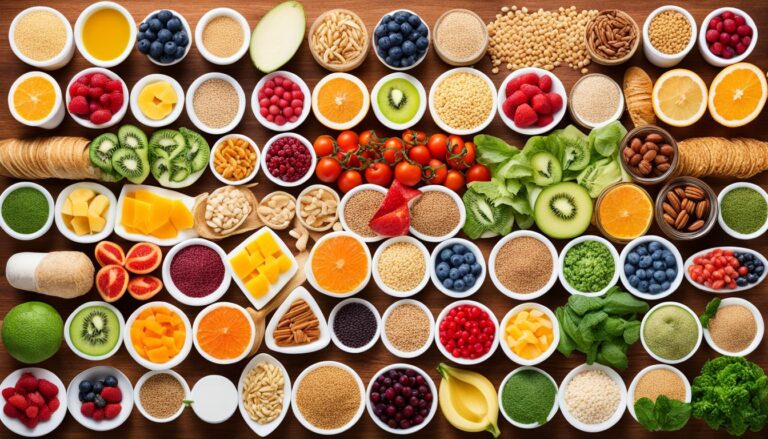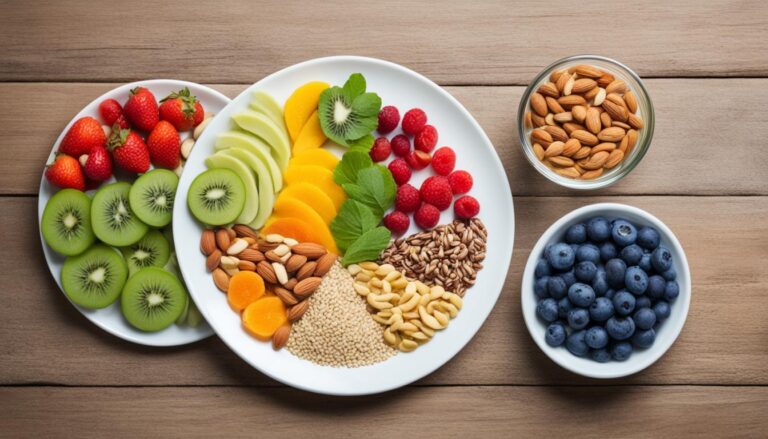Are you looking to enhance your meals with a protein-packed punch? If so, you’re in the right place! Protein is a vital nutrient that supports muscle growth, aids in weight management, and contributes to overall health. But how can you easily add more protein to your diet without sacrificing taste or convenience? Get ready to uncover simple protein boosters, quick protein recipes, and healthy protein options that will leave you feeling satisfied and energized.
Key Takeaways:
- Discover easy ways to incorporate more protein into your meals.
- Explore delicious and convenient protein-rich foods and recipes.
- Learn about protein sources suitable for vegetarians and vegans.
- Understand the benefits of protein supplements and how to choose the right one for you.
- Find out how increasing your protein intake can support your fitness goals and overall well-being.
Understanding the Importance of Protein in Your Diet
Protein is a fundamental nutrient that impacts numerous functions in the body. Its importance cannot be overstated when it comes to muscle growth, weight management, and overall health. Incorporating an adequate amount of protein into your diet is crucial for maintaining optimal well-being. In this section, we will explore the benefits of a protein-rich diet, the recommended protein intake for optimal health, and the role protein plays in muscle growth and weight management.
Benefits of a Protein-Rich Diet
A protein-rich diet offers a myriad of benefits for your body and mind. Here are some key advantages:
- Supports Muscle Development: Protein provides the building blocks for muscle growth and repair. Consuming sufficient protein can aid in maintaining and building lean muscle mass.
- Boosts Metabolism: Protein has a higher thermic effect compared to fats and carbohydrates, meaning your body burns more calories digesting protein. This can support weight management and enhance metabolic rate.
- Increases Satiety: Protein-rich foods help you feel fuller for longer, reducing hunger cravings and promoting healthy portion control.
- Improves Bone Health: Adequate protein intake is associated with improved bone density and reduced risk of osteoporosis.
- Enhances Cognitive Function: Protein is essential for the production of neurotransmitters that play a crucial role in mental alertness, focus, and overall brain function.
Recommended Protein Intake for Optimal Health
The recommended protein intake varies based on factors such as age, sex, activity level, and individual goals. On average, it is recommended that adults consume approximately 0.8 grams of protein per kilogram of body weight. However, individuals engaging in regular physical activity or aiming for muscle growth may require a higher protein intake.
Here is a general guideline for protein intake based on activity levels:
| Activity Level | Recommended Protein Intake |
|---|---|
| Sedentary Lifestyle | 0.8 grams per kilogram of body weight |
| Moderate Exercise | 1.2-1.4 grams per kilogram of body weight |
| Strength Training | 1.6-2.0 grams per kilogram of body weight |
| Endurance Training | 1.2-2.0 grams per kilogram of body weight |
These recommendations can serve as a starting point, but it’s important to consult with a healthcare professional or registered dietitian to determine the ideal protein intake for your specific needs.
Protein’s Role in Muscle Growth and Weight Management

Protein plays a pivotal role in muscle growth and weight management. Adequate protein consumption is vital for:
- Building and Repairing Muscles: When you engage in strength training or physical activity, protein supplies the amino acids necessary for muscle repair and growth.
- Promoting Fat Loss: Protein has a higher thermic effect, which means it requires more energy to digest, leading to increased calorie burn. Additionally, protein can help preserve muscle mass during weight loss, preventing muscle loss and promoting fat loss.
- Curbing Appetite: Protein-rich foods provide greater satiety, reducing hunger pangs and preventing overeating. This can be particularly beneficial for weight management.
By understanding protein’s crucial role in muscle growth and weight management, you can make informed decisions about your dietary choices, ensuring you prioritize protein-rich foods and maintain a healthy lifestyle.
Starting Your Day with High-Protein Breakfast Options
Substitute Cereal with Protein-Packed Eggs
Forget the bland cereal and upgrade your breakfast game with protein-packed eggs. Eggs are a fantastic source of high-quality protein, containing all the essential amino acids your body needs. They are not only delicious but also incredibly versatile, allowing you to prepare them in numerous ways to suit your palate. Whether you prefer a classic scramble, a fluffy omelet, or a poached egg on whole grain toast, incorporating eggs into your morning routine will provide you with a satisfying and protein-rich start to your day.

The Power of Greek Yogurt to Satisfy Your Morning Hunger
When it comes to protein-rich breakfast options, Greek yogurt takes center stage. This creamy and tangy delight is packed with protein, making it an excellent choice for those who prefer a lighter morning meal. Greek yogurt contains more protein compared to regular yogurt due to the straining process, where liquid whey is removed. Opt for plain Greek yogurt and add your favorite fruits, nuts, or granola for a delicious and nutritious combination. It’s a breakfast that will keep you fuelled and satisfied until lunchtime.
High Protein Snacks: Quick and Satisfying Options
Sometimes, we need a quick and satisfying snack to keep us fueled between meals. In this section, we’ll explore high protein snack options that are both convenient and delicious. Whether you’re on-the-go or need a boost of energy during the day, these protein-rich snacks will keep you satisfied and nourished.
Choosing Cheese and Nuts for Protein-Boosted Snacking
When it comes to high protein snacks, cheese and nuts are your new best friends. Not only are they packed with protein, but they also offer a satisfying crunch and a burst of flavor. Consider incorporating protein-rich cheese varieties like cheddar, Swiss, and cottage cheese into your snacking routine. Pair them with some protein-packed nuts, such as almonds, cashews, or pistachios, for a well-rounded and delicious snack.
Lean Jerky and Edamame: Protein On-the-Go
For those times when you need protein on-the-go, lean jerky and edamame are excellent options. Lean jerky, made from beef, turkey, or other lean meats, is not only high in protein but also low in fat. It provides a convenient and portable snack that will keep you satisfied until your next meal. Edamame, young soybeans, is another protein-packed snack that can be enjoyed as a quick and healthy on-the-go option. These little green beans are not only delicious but also loaded with nutrients.
| Snack | Protein Content per Serving |
|---|---|
| Protein-rich cheese | Varies depending on the type of cheese, ranging from 6-8 grams per ounce |
| Protein-packed nuts | Varies depending on the type of nut, ranging from 4-8 grams per ounce |
| Lean jerky | Around 20 grams of protein per 1-ounce serving |
| Edamame | Around 17 grams of protein per 1-cup serving |
With these protein-rich snacks, you’ll be able to curb your hunger, stay energized throughout the day, and enjoy a guilt-free treat. Whether you’re at work, traveling, or simply in need of a quick pick-me-up, these high protein snack options are sure to satisfy your cravings while supporting your health and wellness goals.
Easy Ways to Add Protein to Your Diet
In this section, we’ll explore additional easy ways to add protein to your overall diet. With a few simple protein boosters and incorporating protein-rich meals, you can increase your protein intake and enjoy a varied and nutritious diet.
One easy way to add protein to your meals is by including extra lean meat or beans. Lean meats like chicken, turkey, and fish are excellent sources of protein. Try adding grilled chicken breast to salads or sandwiches, or include lean ground turkey in your stir-fries. Beans are also a versatile and protein-rich option. Add black beans to tacos or make a delicious bean salad as a side dish.
Another way to increase your protein intake is to choose protein-rich meals. Opt for dishes that include protein sources like tofu, tempeh, or seitan for vegetarian or vegan options. Incorporate eggs, cottage cheese, or Greek yogurt into your breakfast for a protein-packed start to your day. For dinner, include a seafood dish like salmon or shrimp for a delicious and protein-rich meal.
It’s important to choose protein sources that align with your dietary preferences. Make sure to include a variety of protein-rich foods to ensure you’re getting all the essential amino acids your body needs.
To recap, here are some easy ways to add protein to your diet:
- Add extra lean meat or beans to your meals
- Choose protein-rich meals with tofu, tempeh, or seitan
- Incorporate eggs, cottage cheese, or Greek yogurt into your breakfast
- Include seafood dishes like salmon or shrimp in your dinner options
By following these easy strategies, you’ll be able to meet your protein needs and enjoy a balanced and nutritious diet. Now, let’s move on to exploring the benefits of incorporating legumes and beans into your meals.

Plant-Based Protein: Incorporating Legumes and Beans into Meals
If you’re following a vegetarian or vegan diet or simply looking to incorporate more plant-based foods into your meals, legumes and beans are excellent sources of plant-based protein. Not only are they rich in protein, but they also provide a wide range of nutritional benefits that can contribute to your overall health.
Benefits of Adding Legumes to Your Diet
Legumes, which include beans, lentils, and chickpeas, offer numerous health benefits that make them a valuable addition to your diet. Here are some reasons why you should consider incorporating legumes into your meals:
- Rich in Protein: Legumes are an excellent plant-based protein source, making them a suitable choice for vegetarians and vegans looking to meet their protein requirements. They provide essential amino acids needed for muscle repair and growth.
- High in Fiber: Legumes are a great source of dietary fiber, which can aid in digestion, promote gut health, and help regulate blood sugar levels and cholesterol levels.
- Packed with Nutrients: Legumes are rich in vitamins, minerals, and antioxidants, such as iron, zinc, folate, and potassium. These nutrients contribute to overall health and support various bodily functions.
- Heart-Healthy: Legumes have been associated with a reduced risk of cardiovascular diseases. Their high fiber and low saturated fat content contribute to heart health by promoting healthy cholesterol levels and supporting a healthy cardiovascular system.
- Weight Management: Legumes are filling due to their high fiber and protein content, which can help with weight management by promoting feelings of fullness and reducing calorie intake.
Creative Recipes with Beans for a Protein Surge
Looking for creative ways to incorporate beans into your meals? Here are some protein-packed and delicious recipes that will satisfy your taste buds:
Bean and Vegetable Stir-Fry:
Sautee a mixture of your favorite beans, colorful vegetables, and aromatic spices. Serve over quinoa or brown rice for a wholesome and protein-rich meal.
Black Bean Burger:
Make a flavorful black bean patty mixed with breadcrumbs, onions, and spices. Cook on a grill or stovetop and serve on a whole-grain bun with your favorite toppings.
Chickpea Salad:
Combine chickpeas with chopped cucumbers, tomatoes, red onions, fresh herbs, and a light lemon tahini dressing. This refreshing salad is packed with protein and makes a perfect light lunch or side dish.
Lentil Curry:
Simmer lentils with coconut milk, tomatoes, onions, and a blend of aromatic spices. Serve over basmati rice or with naan bread for a hearty and protein-rich vegetarian curry.
These recipes showcase the versatility of beans and legumes and how they can be transformed into delicious and protein-packed vegetarian meals. Experiment with different types of beans and get creative in the kitchen for a protein surge that will leave you satisfied and nourished.

Protein Supplements: Enhancing Your Diet with Powder and Shakes
Protein supplements can be a game-changer when it comes to meeting your daily protein needs and enhancing your diet. Whether you’re a fitness enthusiast, an athlete, or simply looking to increase your protein intake, protein powders and shakes are convenient options to consider. In this section, we’ll explore different types of protein powders and provide you with some delicious homemade protein shake recipes to enjoy throughout the day.
Getting to Know Different Types of Protein Powders
When it comes to protein powders, there are various options available, each with its unique benefits and considerations. Three popular types of protein powders include whey, soy, and pea protein.
Whey Protein: Derived from milk during the cheese-making process, whey protein is a complete protein containing all the essential amino acids. It is quickly absorbed by the body, making it an excellent option for post-workout recovery. Whey protein is known for its muscle-building properties and can help support lean muscle mass.
Soy Protein: Made from soybeans, soy protein is a plant-based protein source that is suitable for vegetarians and vegans. It is also a complete protein and provides a good balance of essential amino acids. Soy protein is known for its potential health benefits, including heart health and hormonal balance.
Pea Protein: Derived from yellow split peas, pea protein is an excellent choice for those with allergies or sensitivities to dairy or soy. It is easy to digest and has a high protein content. Pea protein is also rich in iron, making it a great option for individuals with iron deficiencies or on plant-based diets.
When choosing a protein powder, consider factors such as taste, texture, dietary restrictions, and your specific goals. It’s always a good idea to consult with a healthcare professional or a registered dietitian to determine the best protein powder for your individual needs.
Homemade Protein Shake Recipes for Any Time of the Day
Creating your own homemade protein shakes allows you to customize flavors, ingredients, and nutrient profiles based on your preferences. Here are a few protein shake recipes that you can easily make at home:
- Chocolate Peanut Butter Protein Shake: Blend 1 scoop of chocolate protein powder, 1 tablespoon of peanut butter, 1 frozen banana, 1 cup of almond milk, and a handful of ice cubes for a creamy and indulgent shake.
- Berry Blast Protein Shake: Combine 1 scoop of vanilla protein powder, 1 cup of mixed berries (such as strawberries, blueberries, and raspberries), 1 cup of Greek yogurt, and 1 cup of unsweetened almond milk in a blender. Blend until smooth and enjoy the refreshing taste of summer.
- Green Protein Power Shake: For a nutritious and energizing shake, blend 1 scoop of vanilla or unflavored protein powder, 1 cup of spinach, 1 frozen banana, 1 tablespoon of almond butter, and 1 cup of coconut water. This shake is packed with vitamins, minerals, and antioxidants.
Feel free to experiment with different protein powders and ingredients to create your own unique protein shake recipes. Don’t forget to add some ice cubes for a refreshing texture and blend until smooth. Cheers to a protein-packed and delicious shake!

Conclusion
As we wrap up this article, it’s crystal clear that incorporating protein into your meals is the key to unlocking optimal health, muscle growth, and weight management. We’ve explored a plethora of easy ways to add protein to your diet, ensuring that you can boost your protein intake without sacrificing taste or convenience.
Whether you prefer starting your day with protein-packed eggs or indulging in a creamy Greek yogurt, there are endless options to suit your breakfast cravings. And when hunger strikes between meals, you can rely on protein-rich snacks like cheese, nuts, lean jerky, and edamame to keep you satisfied and energized.
For those following a vegetarian or vegan lifestyle, incorporating legumes and beans into meals is a fantastic way to obtain plant-based protein while enjoying a variety of flavors and textures. And if you’re seeking an extra protein boost, protein supplements in the form of powders and shakes can be your go-to option.
By prioritizing protein in your meals, you’ll be on your way to a healthier, more fulfilling lifestyle. Remember, it’s not just about the quantity of protein, but also about the quality. So choose protein-rich sources that align with your dietary preferences and savor the benefits of a protein-rich diet.





